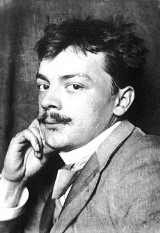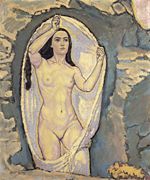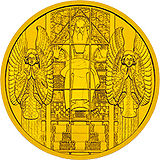
Koloman Moser
Encyclopedia
Koloman Moser (ˈkoːloman ˈmoːzɐ) (March 30, 1868 – October 18, 1918) was an Austria
n artist who exerted considerable influence on twentieth-century graphic art and one of the foremost artists of the Vienna Secession
movement and a co-founder of Wiener Werkstätte
.
During his life, Moser designed a wide array of art works - books and graphic works from postage stamp
s to magazine vignettes; fashion; stained glass windows, porcelains and ceramics, blown glass, tableware, silver, jewelry, and furniture - to name a few of his interests.
 Born in Vienna
Born in Vienna
, he studied at the Wiener Akademie and the Kunstgewerbeschule
, where he also taught from 1899.
His designs in architecture, furniture, jewelry, graphics, and tapestries helped characterize the work of this era. Moser drew upon the clean lines and repetitive motifs of classical Greek and Roman art and architecture in reaction to the Baroque decadence of his turn-of-the-century Viennese surroundings.
In 1901/1902, he published a portfolio titled Die Quelle ("The Source") of elegant graphic designs for such things as tapestries, fabrics, and wallpaper.
In 1903, Moser and his colleague Josef Hoffmann
founded Wiener Werkstätte
, whose studios and artisans produced a number of aesthetically and functionally designed household goods, including glassware, flatware, silverware, and textiles. In 1904, he created the Apse
mosaic
and glass windows for the Kirche am Steinhof
in Vienna.
 In 1905, together with the Klimt
In 1905, together with the Klimt
group, he separated from the Vienna Secession
. The same year, he married Editha (Ditha) Mautner von Markhof, the daughter to one of Austria's great industry fortunes.
In 1907 Kolo Moser, due to internal conflicts and as his plans for reorganising the Werkstätte (to cope with financial problems) weren't realised, withdrew from the Wiener Werkstätte
.
Koloman was one of the designers for Austria's leading art journal Ver Sacrum. This art journal paid great attention to design and was designed mainly by Moser, Gustav Klimt and Josef Hoffmann.
.
On May 3, 2010 Swann Galleries
auctioned the third volume in Moser's three-volume series "Die Quelle," containing 30 sumptuous decorations for flat surfaces, such as tapestries, wallpaper and fabrics, in the original portfolio. Each plate was double sided, with a color design on one side and a black-and-white design on the other. It sold for an auction record price of $12,600.
Austria
Austria , officially the Republic of Austria , is a landlocked country of roughly 8.4 million people in Central Europe. It is bordered by the Czech Republic and Germany to the north, Slovakia and Hungary to the east, Slovenia and Italy to the south, and Switzerland and Liechtenstein to the...
n artist who exerted considerable influence on twentieth-century graphic art and one of the foremost artists of the Vienna Secession
Vienna Secession
The Vienna Secession was formed in 1897 by a group of Austrian artists who had resigned from the Association of Austrian Artists, housed in the Vienna Künstlerhaus. This movement included painters, sculptors, and architects...
movement and a co-founder of Wiener Werkstätte
Wiener Werkstätte
Established in 1903, the Wiener Werkstätte was a production community of visual artists. The workshop brought together architects, artists and designers whose first commitment was to design art which would be accessible to everyone...
.
During his life, Moser designed a wide array of art works - books and graphic works from postage stamp
Postage stamp
A postage stamp is a small piece of paper that is purchased and displayed on an item of mail as evidence of payment of postage. Typically, stamps are made from special paper, with a national designation and denomination on the face, and a gum adhesive on the reverse side...
s to magazine vignettes; fashion; stained glass windows, porcelains and ceramics, blown glass, tableware, silver, jewelry, and furniture - to name a few of his interests.
Biography

Vienna
Vienna is the capital and largest city of the Republic of Austria and one of the nine states of Austria. Vienna is Austria's primary city, with a population of about 1.723 million , and is by far the largest city in Austria, as well as its cultural, economic, and political centre...
, he studied at the Wiener Akademie and the Kunstgewerbeschule
Kunstgewerbeschule
A Kunstgewerbeschule was the old name for an advanced school of applied arts in German-speaking countries. The first such schools were opened in Kassel in 1867 and Berlin and Munich in 1868 with other German towns following. They are now merged into universities....
, where he also taught from 1899.
His designs in architecture, furniture, jewelry, graphics, and tapestries helped characterize the work of this era. Moser drew upon the clean lines and repetitive motifs of classical Greek and Roman art and architecture in reaction to the Baroque decadence of his turn-of-the-century Viennese surroundings.
In 1901/1902, he published a portfolio titled Die Quelle ("The Source") of elegant graphic designs for such things as tapestries, fabrics, and wallpaper.
In 1903, Moser and his colleague Josef Hoffmann
Josef Hoffmann
Josef Hoffmann was an Austrian architect and designer of consumer goods.- Biography :...
founded Wiener Werkstätte
Wiener Werkstätte
Established in 1903, the Wiener Werkstätte was a production community of visual artists. The workshop brought together architects, artists and designers whose first commitment was to design art which would be accessible to everyone...
, whose studios and artisans produced a number of aesthetically and functionally designed household goods, including glassware, flatware, silverware, and textiles. In 1904, he created the Apse
Apse
In architecture, the apse is a semicircular recess covered with a hemispherical vault or semi-dome...
mosaic
Mosaic
Mosaic is the art of creating images with an assemblage of small pieces of colored glass, stone, or other materials. It may be a technique of decorative art, an aspect of interior decoration, or of cultural and spiritual significance as in a cathedral...
and glass windows for the Kirche am Steinhof
Kirche am Steinhof
The Kirche am Steinhof in Vienna is the Roman Catholic oratory of the Steinhof Psychiatric Hospital...
in Vienna.

Gustav Klimt
Gustav Klimt was an Austrian Symbolist painter and one of the most prominent members of the Vienna Secession movement. His major works include paintings, murals, sketches, and other art objects...
group, he separated from the Vienna Secession
Vienna Secession
The Vienna Secession was formed in 1897 by a group of Austrian artists who had resigned from the Association of Austrian Artists, housed in the Vienna Künstlerhaus. This movement included painters, sculptors, and architects...
. The same year, he married Editha (Ditha) Mautner von Markhof, the daughter to one of Austria's great industry fortunes.
In 1907 Kolo Moser, due to internal conflicts and as his plans for reorganising the Werkstätte (to cope with financial problems) weren't realised, withdrew from the Wiener Werkstätte
Wiener Werkstätte
Established in 1903, the Wiener Werkstätte was a production community of visual artists. The workshop brought together architects, artists and designers whose first commitment was to design art which would be accessible to everyone...
.
Koloman was one of the designers for Austria's leading art journal Ver Sacrum. This art journal paid great attention to design and was designed mainly by Moser, Gustav Klimt and Josef Hoffmann.
See also
One of Moser's most prominent designs used in a building (The Steinhof Church) was selected as a main motif of one of the most famous euro collectors coins: the Austrian 100 euro Steinhof Church commemorative coin, minted on November 9, 2005. On the reverse of the coin, the Koloman Moser stained glass window over the main entrance can be seen. In the center of the window is God the Father seated on a throne. The window is flanked with a pair of bronze angels in Jugendstil style, originally designed by Othmar SchimkowitzOthmar Schimkowitz
Othmar Schimkowitz was a Hungarian-born architectural sculptor who worked on the greatest landmarks of the Vienna Secession.-Life:...
.
On May 3, 2010 Swann Galleries
Swann Galleries
Swann Galleries is a New York auction house founded in 1941. It is a specialist auctioneer of antique and rare works on paper, and it is considered the oldest continually operating New York specialist auction house....
auctioned the third volume in Moser's three-volume series "Die Quelle," containing 30 sumptuous decorations for flat surfaces, such as tapestries, wallpaper and fabrics, in the original portfolio. Each plate was double sided, with a color design on one side and a black-and-white design on the other. It sold for an auction record price of $12,600.

